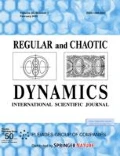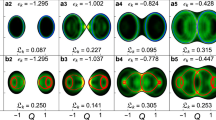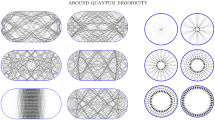Abstract
This is a short review of the theory of chaos in Bohmian quantum mechanics based on our series of works in this field. Our first result is the development of a generic theoretical mechanism responsible for the generation of chaos in an arbitrary Bohmian system (in 2 and 3 dimensions). This mechanism allows us to explore the effect of chaos on Bohmian trajectories and study in detail (both analytically and numerically) the different kinds of Bohmian trajectories where, in general, chaos and order coexist. Finally, we explore the effect of quantum entanglement on the evolution of the Bohmian trajectories and study chaos and ergodicity in qubit systems which are of great theoretical and practical interest. We find that the chaotic trajectories are also ergodic, i. e., they give the same final distribution of their points after a long time regardless of their initial conditions. In the case of strong entanglement most trajectories are chaotic and ergodic and an arbitrary initial distribution of particles will tend to Born’s rule over the course of time. On the other hand, in the case of weak entanglement the distribution of Born’s rule is dominated by ordered trajectories and consequently an arbitrary initial configuration of particles will not tend, in general, to Born’s rule unless it is initially satisfied. Our results shed light on a fundamental problem in Bohmian mechanics, namely, whether there is a dynamical approximation of Born’s rule by an arbitrary initial distribution of Bohmian particles.
























Similar content being viewed by others
Change history
22 January 2021
Changes in the attributes of the ImageObject (img) tag in the HTML file
Notes
BQM is also related to the hydrodynamical formulation of QM made by Madelung in 1927 [6].
There are only exceptions referring to the measurement of time, as the one that has has been considered in detail by Delis, Efthymiopoulos and Contopoulos in [9].
In quantum computing we define the qubit as the unit of quantum information. The physical realization of a qubit is a quantum mechanical system with two well-defined states [58].
References
Ballentine, L. E., Quantum Mechanics: A Modern Development, Singapore: World Sci., 1998.
de Broglie, L., La structure atomique de la matière et du rayonnement et la mécanique ondulatoire, C. R. Acad. Sci. Paris, 1927, vol. 184, pp. 273–274.
de Broglie, L., Sur le rôle des ondes continues en mécanique ondulatoire, C. R. Acad. Sci. Paris, 1927, vol. 185, pp. 380–382.
Bohm, D., A Suggested Interpretation of the Quantum Theory in Terms of “Hidden” Variables: 1, Phys. Rev., 1952, vol. 85, no. 2, pp. 166–179.
Bohm, D., A Suggested Interpretation of the Quantum Theory in Terms of “Hidden” Variables: 2, Phys. Rev., 1952, vol. 85, no. 2, pp. 180–193.
Madelung, E., Quantentheorie in hydrodynamischer Form, Z. Phys., 1927, vol. 40, pp. 322–326.
Bell, J. S., Speakable and Unspeakable in Quantum Mechanics: Collected Papers on Quantum Philosophy, Cambridge: Cambridge Univ. Press, 1987.
Holland, P. R., The Quantum Theory of Motion: An Account of the de Broglie – Bohm Causal Interpretation of Quantum Mechanics, Cambridge: Cambridge Univ. Press, 1995.
Delis, N., Efthymiopoulos, C., and Contopoulos, G., Quantum Vortices and Trajectories in Particle Diffraction, Internat. J. Bifur. Chaos Appl. Sci. Engrg., 2012, vol. 22, no. 9, 1250214, 17 pp.
Wyatt, R. E., Quantum Dynamics with Trajectories: Introduction to Quantum Hydrodynamics, New York: Springer, 2005.
Nikolić, H., Would Bohr Be Born If Bohm Were Born before Born?, Am. J. Phys., 2008, vol. 76, no. 2, pp. 143–146.
Pladevall, X. O. and Mompart, J., Applied Bohmian Mechanics: From Nanoscale Systems to Cosmology, Singapore: Jenny Stanford Publ., 2019.
Sanz, Á. S. and Miret-Artés, S., A Trajectory Description of Quantum Processes. 1. Fundamentals: A Bohmian Perspective, Berlin: Springer, 2012.
Sanz, Á. S. and Miret-Artés, S., A Trajectory Description of Quantum Processes. 2. Applications: A Bohmian Perspective, Berlin: Springer, 2014.
Sanz, Á. S., Bohm’s Approach to Quantum Mechanics: Alternative Theory or Practical Picture?, Front. Phys., 2019, vol. 14, no. 1, 11301, pp.
Kocsis, S., Braverman, B., Ravets, S., Stevens, M. J., Mirin, R. P., Shalm, L. K., and Steinberg, A. M., Observing the Average Trajectories of Single Photons in a Two-Slit Interferometer, Science, 2011, vol. 332, no. 6034, pp. 1170–1173.
Berry, M. V., The Bakerian Lecture, 1987: Quantum Chaology, Proc. Roy. Soc. London Ser. A, 1987, vol. 413, no. 1844, pp. 183–198.
Gutzwiller, M. C., Chaos in Classical and Quantum Mechanics, New York: Springer, 2013.
Robnik, M., Fundamental Concepts of Quantum Chaos, Eur. Phys. J. Spec. Top., 2016, vol. 225, pp. 959–976.
Dürr, D., Goldstein, S., and Zanghi, N., Quantum Chaos, Classical Randomness, and Bohmian Mechanics, J. Stat. Phys., 1992, vol. 68, pp. 259–270.
Parmenter, R. H. and Valentine, R. W., Deterministic Chaos and the Causal Interpretation of Quantum Mechanics, Phys. Lett. A, 1995, vol. 201, no. 1, pp. 1–8.
Faisal, F. H. M. and Schwengelbeck, U., Unified Theory of Lyapunov Exponents and a Positive Example of Deterministic Quantum Chaos, Phys. Lett. A, 1995, vol. 207, no. 1–2, pp. 31–36.
Schwengelbeck, U. and Faisal, F. H. M., Definition of Lyapunov Exponents and KS Entropy in Quantum Dynamics, Phys. Lett. A, 1995, vol. 199, no. 5–6, pp. 281–286.
Iacomelli, G. and Pettini, M., Regular and Chaotic Quantum Motions, Phys. Lett. A, 1996, vol. 212, no. 1–2, pp. 29–38.
Sengupta, S. and Chattaraj, P., The Quantum Theory of Motion and Signatures of Chaos in the Quantum Behaviour of a Classically Chaotic System, Phys. Lett. A, 1996, vol. 215, no. 3–4, pp. 119–127.
García de Polavieja, G., Exponential Divergence of Neighboring Quantal Trajectories, Phys. Rev. A, 1996, vol. 53, no. 4, pp. 2059–2061.
Parmenter, R. H. and Valentine, R. W., Chaotic Causal Trajectories Associated with a Single Stationary State of a System of Noninteracting Particles, Phys. Lett. A, 1997, vol. 227, no. 1–2, pp. 5–14.
Frisk, H., Properties of the Trajectories in Bohmian Mechanics, Phys. Lett. A, 1997, vol. 227, no. 3–4, pp. 139–142.
Konkel, S. and Makowski, A., Regular and Chaotic Causal Trajectories for the Bohm Potential in a Restricted Space, Phys. Lett. A, 1998, vol. 238, no. 2–3, pp. 95–100.
Wu, H. and Sprung, D., Quantum Chaos in Terms of Bohm Trajectories, Phys. Lett. A, 1999, vol. 261, no. 3–4, pp. 150–157.
Cushing, J. T., Bohmian Insights into Quantum Chaos, Philos. Sci., 2000, vol. 67, pp. S430-S445.
Makowski, A., Pepłowski, P., and Dembiński, S., Chaotic Causal Trajectories: The Role of the Phase of Stationary States, Phys. Lett. A, 2000, vol. 266, no. 4–6, pp. 241–248.
Falsaperla, P. and Fonte, G., On the Motion of a Single Particle near a Nodal Line in the de Broglie – Bohm Interpretation of Quantum Mechanics, Phys. Lett. A, 2003, vol. 316, no. 6, pp. 382–390.
Wisniacki, D. A. and Pujals, E. R., Motion of Vortices Implies Chaos in Bohmian Mechanics, Europhys. Lett., 2005, vol. 71, no. 2, pp. 159–165.
Wisniacki, D. A., Pujals, E. R., and Borondo, F., Vortex Interaction, Chaos and Quantum Probabilities, Europhys. Lett., 2006, vol. 73, no. 5, pp. 671–676.
Wisniacki, D. A., Pujals, E. R., and Borondo, F., Vortex Dynamics and Their Interactions in Quantum Trajectories, J. Phys. A, 2007, vol. 40, no. 48, pp. 14353–14368.
Borondo, F., Luque, A., Villanueva, J., and Wisniacki, D. A., A Dynamical Systems Approach to Bohmian Trajectories in a 2D Harmonic Oscillator, J. Phys. A, 2009, vol. 42, no. 49, 495103, 14 pp.
Sengupta, S., Khatua, M., and Chattaraj, P. K., Bohmian Trajectory from the “classical” Schrödinger Equation, Chaos, 2014, vol. 24, no. 4, 043123, 5 pp.
Cesa, A., Martin, J., and Struyve, W., Chaotic Bohmian Trajectories for Stationary States, J. Phys. A, 2016, vol. 49, no. 39, 395301, 24 pp.
Efthymiopoulos, C. and Contopoulos, G., Chaos in Bohmian Quantum Mechanics, J. Phys. A, 2006, vol. 39, no. 8, pp. 1819–1852.
Contopoulos, G., Efthymiopoulos, C., and Harsoula, M., Order and Chaos in Quantum Mechanics, Nonlinear Phenom. Complex Syst., 2008, vol. 11, no. 2, pp. 107–120.
Efthymiopoulos, C., Kalapotharakos, C., and Contopoulos, G., Origin of Chaos near Critical Points of Quantum Flow, Phys. Rev. E (3), 2009, vol. 79, no. 3, 036203, 18 pp.
Tzemos, A. C., Contopoulos, G., and Efthymiopoulos, C., Bohmian Trajectories in an Entangled Two-Qubit System, Phys. Scr., 2019, vol. 94, no. 10, 105218, 20 pp.
Tzemos, A. C., Efthymiopoulos, C., and Contopoulos, G., Origin of Chaos near Three-Dimensional Quantum Vortices: A General Bohmian Theory, Phys. Rev. E, 2018, vol. 97, no. 4, 042201, 13 pp.
Contopoulos, G., Tzemos, A. C., and Efthymiopoulos, C., Partial Integrability of 3D Bohmian Trajectories, J. Phys. A, 2017, vol. 50, no. 19, 195101, 13 pp.
Tzemos, A. C. and Contopoulos, G., Integrals of Motion in 3D Bohmian Trajectories, J. Phys. A, 2018, vol. 51, no. 7, 075101, 18 pp.
Bohm, D. and Vigier, J. P., Model of the Causal Interpretation of Quantum Theory in Terms of a Fluid with Irregular Fluctuations, Phys. Rev. (2), 1954, vol. 96, pp. 208–216.
Valentini, A., Signal-Locality, Uncertainty, and the Subquantum \(H\)-Theorem: 1, Phys. Lett. A, 1991, vol. 156, no. 1–2, pp. 5–11.
Valentini, A., Signal-Locality, Uncertainty, and the Subquantum \(H\)-Theorem: 2, Phys. Lett. A, 1991, vol. 158, no. 1–2, pp. 1–8.
Dürr, D., Goldstein, S., and Zanghi, N., Quantum Equilibrium and the Origin of Absolute Uncertainty, J. Statist. Phys., 1992, vol. 67, no. 5–6, pp. 843–907.
Bohm, D. and Hiley, B. J., The Undivided Universe: An Ontological Interpretation of Quantum Theory, London: Routledge, 1993.
Wisniacki, D. A., Borondo, F., and Benito, R. M., Dynamics of Quantum Trajectories in Chaotic Systems, Europhys. Lett., 2003, vol. 64, no. 4, pp. 441–447.
Valentini, A. and Westman, H., Dynamical Origin of Quantum Probabilities, Proc. Roy. Soc. London Ser. A, 2005, vol. 461, no. 2053, pp. 253–272.
Goldstein, S. and Struyve, W., On the Uniqueness of Quantum Equilibrium in Bohmian Mechanics, J. Stat. Phys., 2007, vol. 128, no. 5, pp. 1197–1209.
Towler, M., Russell, N. J., and Valentini, A., Time Scales for Dynamical Relaxation to the Born Rule, Proc. Roy. Soc. London Ser. A, 2011, vol. 468, no. 2140, pp. 990–1013.
Abraham, E., Colin, S., and Valentini, A., Long-Time Relaxation in Pilot-Wave Theory, J. Phys. A, 2014, vol. 47, no. 39, 395306, 19 pp.
Tzemos, A. C. and Contopoulos, G., Chaos and Ergodicity in an Entangled Two-Qubit Bohmian System, Phys. Scr., 2020, vol. 95, no. 6, 065225, pp.
Nielsen, M. A. and Chuang, I. L., Quantum Computation and Quantum Information, Cambridge: Cambridge Univ. Press, 2000.
Funding
This research was conducted in the framework of the program of the RCAAM of Athens "Study of the dynamical evolution of the entanglement and coherence in quantum systems".
Author information
Authors and Affiliations
Corresponding author
Ethics declarations
The authors declare that they have no conflicts of interest.
Additional information
MSC2010
37N20, 81Q50
APPENDIX
The analytical formula of the wave function (7.6) in the position representation reads
The Bohmian equations of motion produced by the wave function (A.1) are
Rights and permissions
About this article
Cite this article
Contopoulos, G., Tzemos, A.C. Chaos in Bohmian Quantum Mechanics: A Short Review. Regul. Chaot. Dyn. 25, 476–495 (2020). https://doi.org/10.1134/S1560354720050056
Received:
Revised:
Accepted:
Published:
Issue Date:
DOI: https://doi.org/10.1134/S1560354720050056




